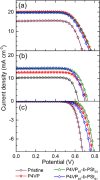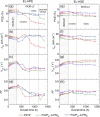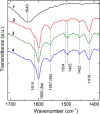Improved Interfacial Electron Dynamics with Block Poly(4-vinylpyridine)-Poly(styrene) Polymers for Efficient and Long-Lasting Dye-Sensitized Solar Cells
- PMID: 39144281
- PMCID: PMC11320385
- DOI: 10.1021/acsapm.4c01238
Improved Interfacial Electron Dynamics with Block Poly(4-vinylpyridine)-Poly(styrene) Polymers for Efficient and Long-Lasting Dye-Sensitized Solar Cells
Abstract
Dye-sensitized solar cells (DSSCs) have recently entered the market for indoor photovoltaics. Fast electron injection from dye to titania, the lifetime of the excited dye, and the suppression of back electron recombination at the photoanode/electrolyte interface are crucial for a high photocurrent conversion efficiency (PCE). This study presents block copolymers of poly(4-vinylpyridine) and poly(styrene)-P4VP67-b-PSt x (x=23;61) as efficient accelerators of electron injection from dye to titania with extended lifetime excited states and long-lasting back electron recombination suppression. P4VP67-b-PSt23 and P4VP67-b-PSt61 rendered devices with PCEs of 10.0 and 9.8%, respectively, under AM 1.5G light; PCEs of 19.4 and 16.4% under 1000 lx LED light were attained. Copolymers provided a stable PCE with the two most popular I3 -/3I- electrolytes based on ACN and 3-methoxypropionitrile solvents; PCE history was tracked in the dark and under 1000 h of continuous light soaking with passive load according to ISOS-D1 and ISOS-L2 aging protocols, respectively. The impact of the polymer molecular structure on electron recombination, charge injection, dye anchoring, light absorption, photocurrent generation, and PCE and the long-term history of photovoltaic metrics are discussed.
© 2024 The Authors. Published by American Chemical Society.
Conflict of interest statement
The authors declare no competing financial interest.
Figures










References
-
- Barichello J.; Mariani P.; Vesce L.; Spadaro D.; Citro I.; Matteocci F.; Bartolotta A.; Di Carlo A.; Calogero G. Bifacial dye-sensitized solar cells for indoor and outdoor renewable energy-based application. J. Mater. Chem. C 2024, 12 (7), 2317–2349. 10.1039/D3TC03220E. - DOI
-
- Zhang D.; Stojanovic M.; Ren Y.; Cao Y.; Eickemeyer F. T.; Socie E.; Vlachopoulos N.; Moser J.-E.; Zakeeruddin S. M.; Hagfeldt A.; Grätzel M. A molecular photosensitizer achieves a Voc of 1.24 V enabling highly efficient and stable dye-sensitized solar cells with copper(II/I)-based electrolyte. Nat. Commun. 2021, 12, 177710.1038/s41467-021-21945-3. - DOI - PMC - PubMed
LinkOut - more resources
Full Text Sources

